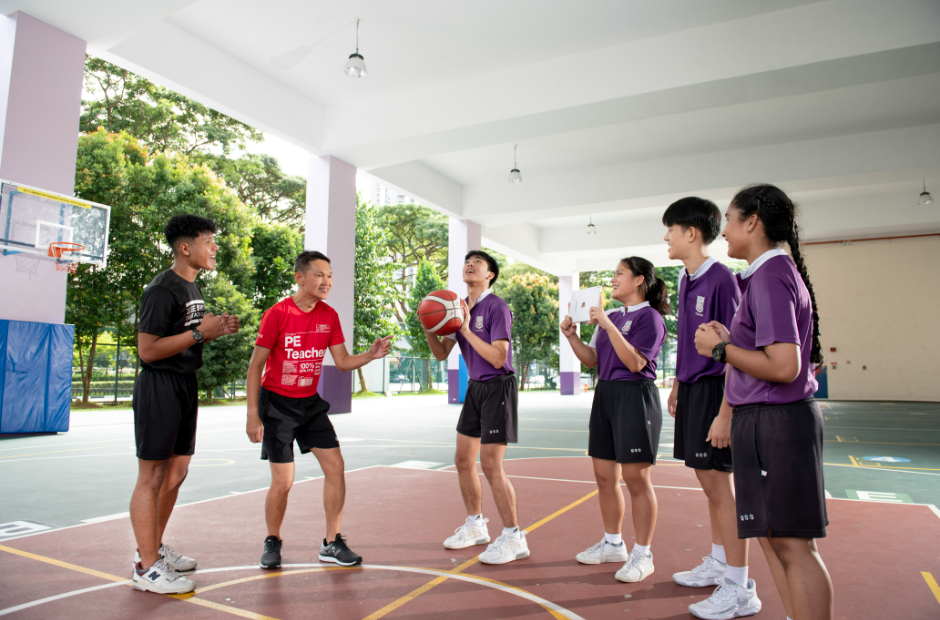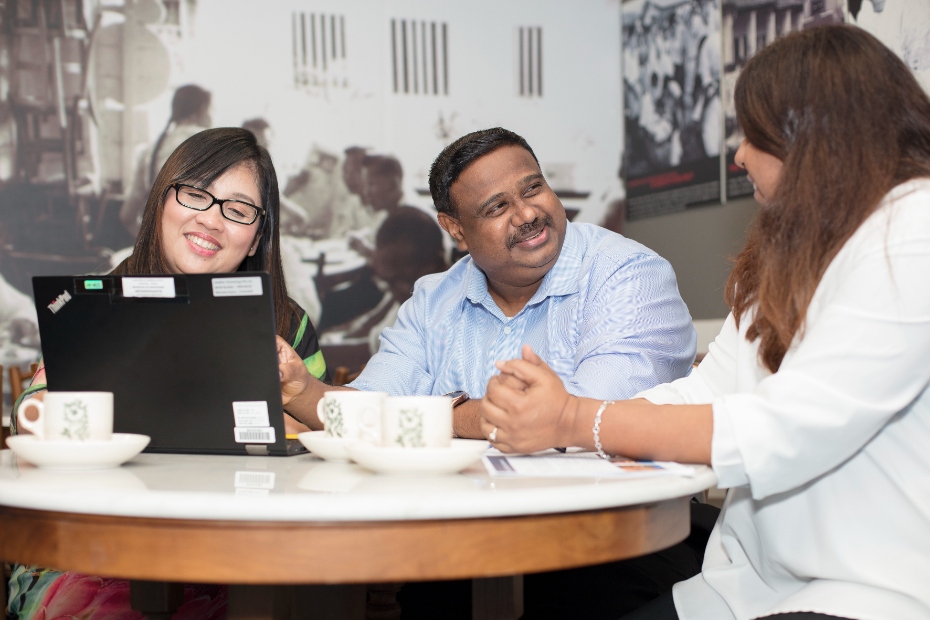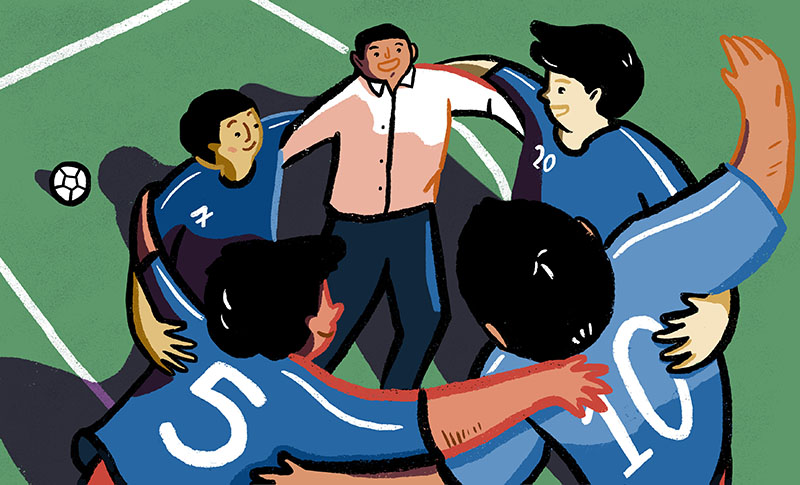The year 2020 was significant to Mr Yeo Choon Hwa for many reasons, starting with the chaos that the Covid-19 pandemic threw the PE department into.
Everywhere, teachers were holding hybrid classes with online tutorials, recording videos and marking e-worksheets, but the football fields, sports halls and rock walls stayed eerily quiet.
When Mr Yeo, the Assistant Year Head at Queensway Secondary School, popped his head into other classes during lesson observations, he saw his colleague teaching Food & Nutrition using Padlet whiteboards, while another colleague was running a Humanities class aided by interactive lesson app Pear Deck.
“I thought, ‘Wow, these tools make the students’ thinking visible!’,” recounts Mr Yeo.
In a flash, he was hit with inspiration. Would e-tools translate well for sports? How does high-tech PE sound? Could we go further than where we were before the pandemic?
After all, his school was already kitted out for it – all his students had Chromebooks, thanks to the Ministry of Education’s Personalised Digital Learning Programme. The school was also well-equipped with 55-inch TVs, even in the sports halls.
Like a man on a mission, Mr Yeo embarked on making the case for tech to plug teaching gaps in PE.
‘Everyone can see where the ball went’
Patching Gap No. 1 was easy.
Whatever the PE classes were doing online in terms of physical activity, Mr Yeo encouraged engagement by getting the students to turn on Padlet’s video platform, record the activity, and do group reviews of their peers’ performance.
He then introduced Pear Deck for students to share their game strategies and moves, and the Heat Map sports app for players to be able to point to exactly where in the court they wanted to hit a volleyball or shuttlecock during a game. Moves could be broken down and critiqued by all.
The tech platforms were an instant hit, for the peer coaching and analyses of techniques and ball trajectories. Suddenly, everyone wanted in on the video action, and students who were not ordinarily active were also chiming in. Tech tools: 1, Covid: 0.

Which brings us to Gap No. 2
Since 2020, Queensway Secondary School has been infusing Differentiated Instruction (DI) into every subject, where teaching is customised to the different needs of the students present.
Because PE is not an examination subject, not every student takes it seriously, says Mr Yeo, while there are other students who are embarrassed about their lack of coordination or assume they would play badly. He believed that DI was a good way to encourage participation on all fronts, and tech was going to lead the way.
He formed a team of educators and they came up with a way to match the recommended DI levers (Content, Process and Product) to the PE setting. Content would cover competitive or non-competitive drills, Process would refer to types of equipment and court layouts, and Product could be quantitative or qualitative assessments.
Using this structure, teachers had a common language and understanding of how they could adjust the levers to suit a student’s needs, such as modifying the sports equipment, task or target. In this way, activities could be adjusted to suit each student’s ability. It was also easier to close the skills gap between the stronger and weaker players.
Finding success, Mr Yeo shared this project at the school’s Learning Festival that same year.
He also shared the team’s tech and DI efforts with MOE’s Physical Education & Sports Teacher Academy (better known as PESTA). “Being passionate may not be enough to change students,” he says. “I learnt the importance of collaborating with like-minded people and the community.”
These days, though school life has returned pretty much to the norm, there is air of progress in the PE Department. The latest developments “align our curriculum with the changing needs of society and the education system”, says Mr Yeo.
It gives them the mindset of excellence…to not be afraid to learn new skills and be confident that they can improve.
Mr Yeo Choon Hwa
Students are also noticeably more enthusiastic about PE. Previously, they might show up at lessons half-heartedly. Now, they tend to come prepared to learn something. “High-tech PE” showed them the possibilities, that they can pick up a sport or improve a skill during PE lessons. When this is incorporated with DI, students not just play with a positive mindset but are also progressing according to their ability and pace.
“It gives them the mindset of excellence,” Mr Yeo says with satisfaction. “It’s one we want them to have, to not be afraid to learn new skills and be confident that they can improve.”
Assists and conversions
Mr Yeo knows what it is like to lack confidence because he’s been there.
He took a longer time with his primary school education, and grew up under the shadow of an older brother who was doing very well in school. He felt like he was “the bad kid in the family”, a feeling made worse by comments some neighbours made. Bitter, he began to misbehave.
It was a new form teacher in Primary 7 who turned him around. Humorous but very strict, Mr Jimmy Tan enforced discipline but also showed care to him, till he too started to believe in himself.
In the same way today, Mr Yeo teaches discipline as a way for his students to achieve their goals in life. DI goes a long way towards helping them get to a point where “they don’t feel undermined”.
Character-building is so important to Mr Yeo, he injected the school’s Values in Action programme into the Basketball CCA he oversees. Values that they learn through CCA can then be applied in service of others outside the classroom, he explains. For example, last year’s Secondary 3 basketballers offered to coach the primary school students.
Years ago, emblematic of how much Mr Yeo wants to be a better teacher to all students, he requested for a secondment to Northlight School, to understand how to better support students at risk of dropping out of school, much like who he was when he was young.
Today, Secondary 3 student Freemen Tan appreciates how Mr Yeo keeps him in school by engaging his interest in sports. There are friends who text and distract him frequently, but Mr Yeo is firm with Freemen about facing the consequences of his actions. “He knows I’m there for him,” Mr Yeo says. “Because I accept him as he is and also see his potential — his leadership, his skills and his competencies – I think that allows him to believe that he’s able to be more than who he is now.”






